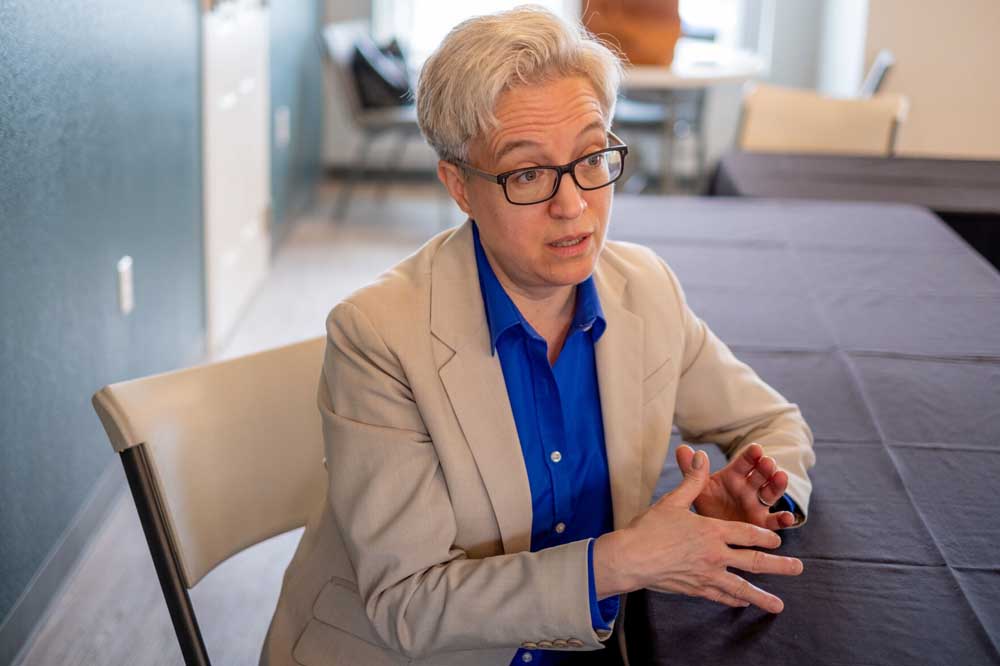Kotek leaves open potential for future urban growth boundary changes
Published 2:00 pm Tuesday, March 5, 2024

- Gov. Tina Kotek, shown here in Pendleton last year, left open the possibility of future urban growth boundary changes in Oregon even though proposed expansion provisions are supposed to be a one-time bypass.
The urban growth boundary expansion working its way through the Oregon Legislature is often billed as a one-time bypass of the state’s normal land use processes.
However, Gov. Tina Kotek doesn’t appear ready to take such options off the table in the future, at least until she sees how effectively the proposed changes will boost housing availability.
“I think we have to see how it works,” Kotek, a Democrat, said during a roundtable interview on Feb. 27 with reporters and editors from EO Media Group. “At this point, I don’t think we need another tool, but we’re going to continue to evaluate year after year.”
Under comprehensive legislation to reduce Oregon’s housing shortage — Senate Bill 1537 — cities can add up to 100 acres to their urban growth boundaries without undertaking analyses legally required under the state’s land use system.
The Portland metropolitan area would also be able to circumvent those steps to increase its urban growth boundary by 300 acres, subject to certain constraints.
The proposal has drawn criticism from some land use advocates, who fear such workarounds are becoming commonplace.
Critics of the one-time urban growth boundary expansion say such actions have already become normalized, as legislation passed last year allows the government to take similar steps to accommodate microchip manufacturing and residential development in Eastern Oregon.
During the interview, Kotek was twice asked if she was willing to commit to SB 1537 being the last one-time urban growth boundary expansion that she’ll support during her tenure as governor.
Rather than make such a commitment, Kotek said only that “we have to see how it works” and that it’s “going to be an evolving conversation about housing production” that includes other factors beyond land supply.
As the impacts are examined over time, “then we can engage in a thoughtful process about whether we need to tweak anything,” Kotek said. “Right now, I think it’s what we need and I think we’re going to have success with it, so I don’t know that we have to have any changes.”
Kotek’s answer wasn’t reassuring to farmland protection advocates who worry that lawmakers are repeatedly overriding urban growth boundary procedures meant to encourage infill and contain sprawl.
Aileen Kaye, a member of the Friends of Marion County nonprofit, called the governor’s comments “disturbing” and “very discouraging,” as they seem to undermine her earlier rhetoric of a one-time urban growth boundary expansion.
“Sounds like a false promise to me,” Kaye said.
Kotek is joining with other proponents of weakening land use protections “to severely erode Oregon’s quality of life and our agricultural base,” Kaye said.
It’s concerning that Kotek advocates the urban growth boundary bypass regardless of the housing needs analysis required under another bill passed in 2023, which was meant to encourage middle-income housing, said Lauri Segel, legal analyst for the Landwatch Lane County nonprofit.
“Yet she continues to push for more of the same, each time with more loopholes for developers,” Segel said.
Defending the expedited urban growth boundary expansion, Kotek stressed it requires at least 30% affordable housing and won’t be available to cities unless they don’t have enough such homes or buildable land within their existing boundaries.
The bill also directs expansions toward previously designated urban reserves and nonresource lands, which is meant to prevent development on prime farmland and forestland.
The expedited process is meant to speed the ability of cities to expand onto land they eventually could have added to their urban growth boundaries anyway, Kotek said.
“It’s a narrow tool. In fact, we got pushback that it’s too narrow,” the governor said. “Not every community can take advantage of it, not every community can use it.”
Some supporters of expedited urban growth boundary expansion, such as Hillsboro, have complained they likely won’t be able to use the process because it sets such a high bar.
Specifically, the bill excludes cities that recently added to their urban growth boundaries and still have more than 20 acres available for residential development, unless they can prove insufficient access to affordable housing.
Emphasizing the need for ongoing assessments, Kotek said the urban growth boundary process may need tightening up if it’s not as protective as intended.
However, she also left open the possibility of future changes if the procedures prove too constrictive.
“I know there’s a lot of concern. We’re going to watch it. We’re going to see how it’s going. If it has to be adjusted because it’s being misused, I want to hear about it,” Kotek said. “If it’s not crafted in a way that’s having an effect, we need to talk about that, too.”
The governor rejected the suggestion that Oregon is now prioritizing housing production over farmland preservation, arguing the two goals aren’t mutually exclusive.
“I don’t think this is a competition. This is not an either/or conversation,” Kotek said. “I think we can have our land use system protect our vibrant farms, our forestland, those things we all hold dear and still have additional housing that, frankly, is important for every community.”





